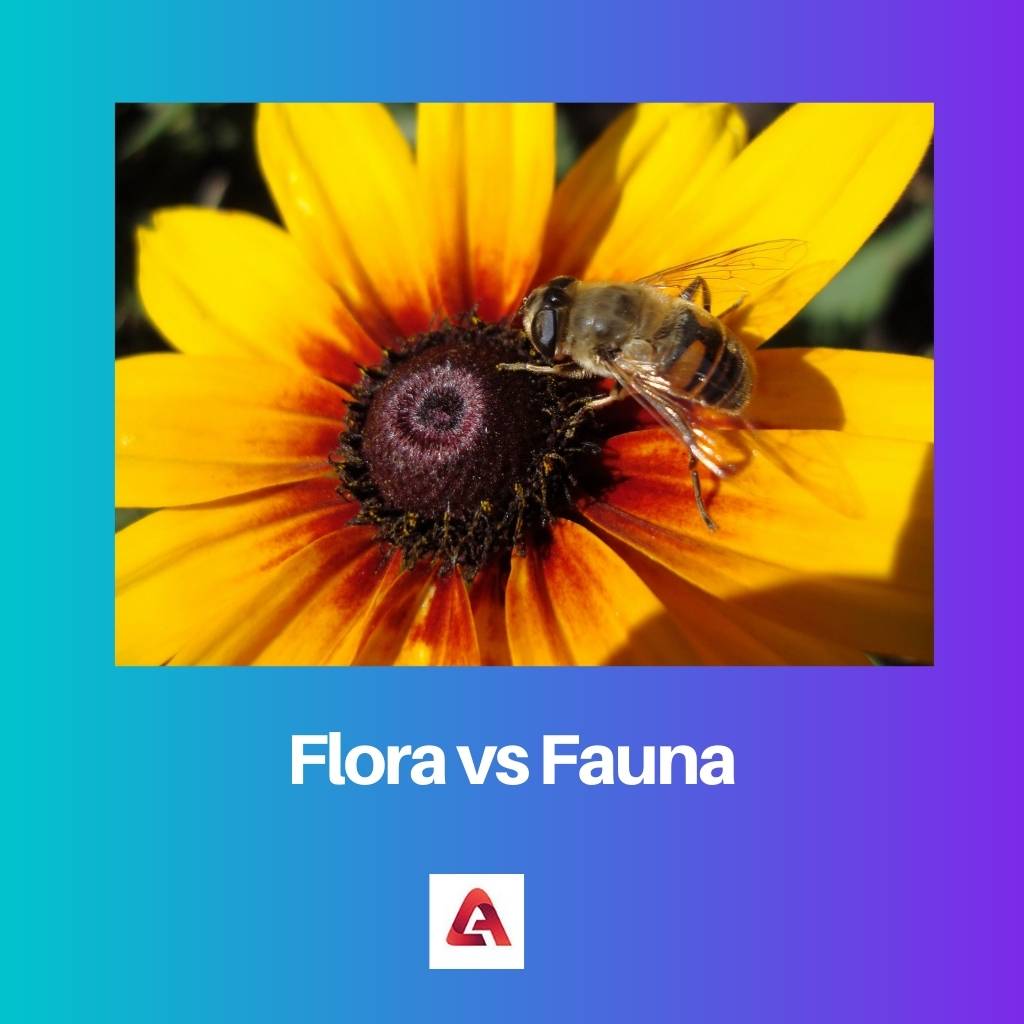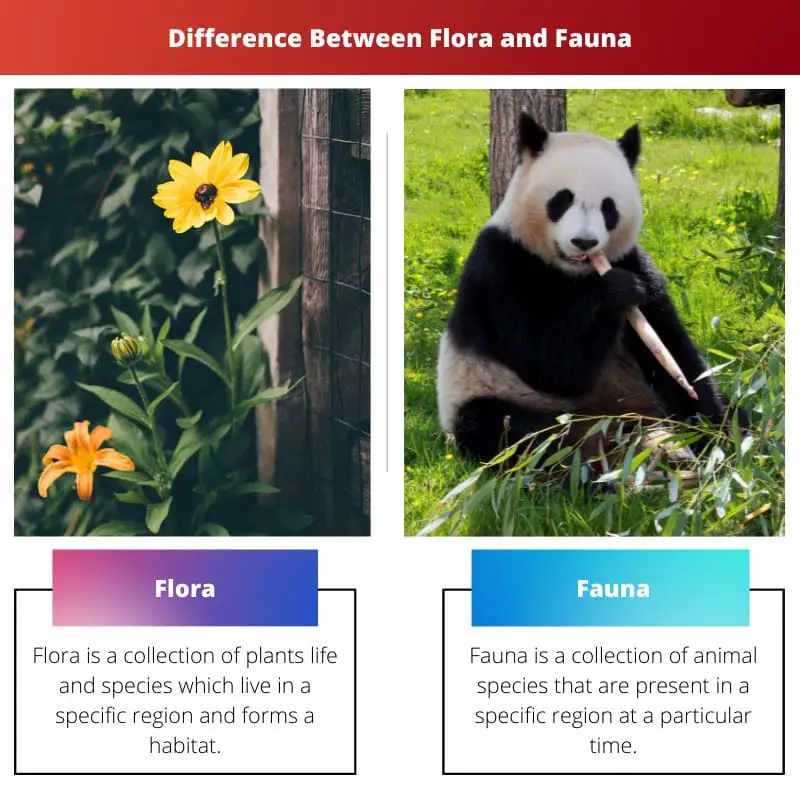The association of living organisms that live together in an environment is called an Ecosystem. Both Biotic and Abiotic components are related to each other via life cycles and energy flow. It is very complex and interconnected.
An ecosystem is determined by many factors. Both external and internal factors are there, like soil, climate, topography, decomposition, types of species living, shading etc. Flora and Fauna are also part of an Ecosystem.
Key Takeaways
- Flora refers to the plant life in a specific region or ecosystem, while fauna refers to the animal life in that area.
- Flora is critical for producing oxygen and providing food and habitat for fauna, while fauna contributes to the health of ecosystems through their role in the food chain.
- Both flora and fauna are essential for maintaining the balance and diversity of ecosystems.
Flora vs Fauna
Flora represents all plant life studied in botany. Most of its members can make their own food but lack mobility, so they stay in one place. Fauna represents all animal life studied in zoology. Its members can move from one place to another and have to acquire food from plants or other animals.

Flora refers to the life of plants that are present in a specific geographical region or are indigenous. Flora consists of all types of plants, algae, bacteria, and fungi. Plants are classified into flora depending upon period, special environment, region (floristic regions), or climate.
When Plants are divided into Flora according to the region, then they can be of different habitats like in the mountains and in oceans. Sometimes when a Plant is discovered from a historical era, then it is termed a Fossil Flora.
Fauna refers to the life of animals that are present in a specific geographical region or are native to that place. Mostly Zoologists and Palaeontologists use the term fauna to refer to the collection of animals that are found in a specific place or time.
The study which is related to the Fauna of a particular area is called faunistic. There are various subdivisions of Fauna depending upon the region they are found in, like Cryptofauna, Epifauna, Infauna etc.
Comparison Table
| Parameters of Comparison | Flora | Fauna |
|---|---|---|
| Nutrition | Autotrophs | Heterotrophs |
| Classification | Horticultural flora, native flora, agricultural flora and weed flora | Infauna, epifauna, cryofauna, limnofauna, stygofauna, troglofauna, xenofauna, cryptofauna,macrofauna etc. |
| Branch | Botany | Zoology, Palaeontology |
| Evolution | First form of life on earth | Developed after flora |
| Locomotion | Immovable | Movable |
| Climate | Affects Flora | Fauna affects it. |
What is Flora?
Flora is a collection of plants, life and species which live in a specific region and forms a habitat. Natural vegetation grows in the ecosystem and is native to its place. Flora contains all the plants, algae etc.
Sometimes even bacteria and fungi are also considered flora. Then they are known by the name skin flora or gut flora. Flora are autotrophs, i.e. they can make their food with the help of photosynthesis. Fauna is dependent on Flora for food.
The term ‘flora’ comes from the Latin word, which means the goddess of plants, fertility and flowers in Roman mythology. Word’ Flora’ came into use at the end of the sixteenth century when the term was used in poetry describing a specific area’s natural vegetation.
Flora was also used to describe flowers in the artificial garden in the 17th century. Earlier term vegetation and flora was used together synonymously. The distinction between the two was first made by Jules Thurmann in 1849.
Flora is classified according to the era(period), environment, climate and region. Its classification includes Weed flora, horticulture flora, also called garden flora, Agricultural Flora and Native Flora.
Flora is studied by botanists, and they come under the branch of Botany. Flora is very important for our environment. It is one of the first life forms that appeared on Earth. Flora consists of cell walls and chloroplast, and they are immovable.

What is Fauna?
Fauna is a collection of animal species that are present in a specific region at a particular time. It consists of various types of animals. Fauna is studied by zoologists and palaeontologists under the branch of Zoology and Palaeontology.
Some of the famous examples of fauna include Burgess Shale fauna, Sonoran desert fauna etc. Palaeontologists find out how there was the development of fauna at different stages by examining fossils which are series of rocks.
Faunistics are the study of animals of a particular region. The term fauna comes from the word ‘Fauna’, which symbolises the Roman Goddess of fertility and earth. In Roman mythology, there exists a Roman God, Faunus, and the forest spirits are called Fauns.
The word was first used by Swedish Zoologist Carl Linnaeus in his work Fauna Suecica in 1745. There are various types of subdivisions of fauna according to region.
They are infauna, epifauna, cryofauna, limnofauna, stygofauna, troglofauna, xenofauna, cryptofauna,macrofauna, megafauna, meiofauna, microfauna etc. Fauna is heterotrophs in nature, i.e., they are dependant on others like flora for food.
They appeared after flora evolved. Chloroplast and cell wall are absent from Fauna. Fauna is movable. Fauna is responsible for affecting climate.

Main Differences Between Flora and Fauna
- Flora is Autotrophs, i.e. can make their food and are independent. Fauna is Heterotrophs, i.e. they are dependent on food.
- Flora is classified based on regions like horticultural flora, native flora, agricultural flora and weed flora. Fauna have various subdivision like epifauna, cryofauna, limnofauna, stygofauna, troglofauna, xenofauna etc.
- Flora is studied in Botany. Fauna is studied under Palaeontology and Zoology.
- Flora evolved first on earth and is considered the first form of life. Fauna evolved after flora.
- Flora is immobile. Fauna is mobile.
- The climate is responsible for affecting Flora. Fauna is responsible for affecting climate.

- https://books.google.com/books?hl=en&lr=&id=wfWNq91AjeoC&oi=fnd&pg=PR11&dq=Flora+and+Fauna&ots=gZk0MWfjoE&sig=Z-_FLHMUB3mAGrrUZIaYNmyUn6Q
- https://www.sciencedirect.com/science/article/pii/S0006320701001914

The comparison table provided in the article is very informative. It clearly outlines the differences between flora and fauna in a very structured manner.
Yes, the table is well-structured and helps to understand the nuances of flora and fauna.
The insights into the historical origins of the terms flora and fauna provide a context that enhances our understanding of these components of an ecosystem.
Absolutely, Alfie Reid. It is fascinating to trace the etymology and evolution of these terms.
Comprehending the historical evolution of flora and fauna enriches our knowledge about the natural world.
The detailed description of the classification of flora and fauna according to environment, climate, region, and era is quite enlightening. It shows the complexity and diversity of ecosystems.
I agree, Mitchell Joshua. The historical background adds depth to the understanding of flora and fauna.
I found the historical context of the terms flora and fauna, provided in the article, particularly interesting.
The relationship between biotic and abiotic components in an Ecosystem is truly fascinating and very complex. This article provides a comprehensive analysis of flora and fauna and their impact on the environment.
I completely agree, Lphillips. The balance of an ecosystem is so delicate and interdependent.
The detailed explanation of the interdependence between flora and fauna offers a profound insight into the functioning of an ecosystem.
I couldn’t agree more, Robertson Alexandra. The delicate balance between flora and fauna is essential for a thriving ecosystem.
The article thoroughly explains the characteristics and the significance of flora and fauna, emphasizing the importance of maintaining a balance in ecosystems.
It’s fascinating how much we rely on the interaction between flora and fauna for a thriving environment.
The article presents comprehensive information about the characteristics and the ecological importance of flora and fauna. This enhances our understanding of the intricacies of ecosystems.
The article’s emphasis on the significance of flora and fauna in maintaining ecological balance is commendable.
The article’s comprehensive overview of flora and fauna, their historical roots, and their ecological significance provides invaluable knowledge about the natural world.
The article has certainly broadened my understanding of the intricacies of flora and fauna. It’s a compelling read.
Agreed, Hbaker. The article’s structured approach to discussing flora and fauna deepens our appreciation of the complexities of ecosystems.
The comparison table effectively summarizes the contrasting characteristics of flora and fauna, enabling a clear understanding of their roles in ecosystems.
The article’s systematic comparison of flora and fauna’s nutritional aspects and impact on the environment is very illuminating.
The article effectively differentiates between flora and fauna, providing insights into their nutritional aspects and their impact on the environment.
The ecosystem would not function harmoniously without the balance between flora and fauna.
I couldn’t agree more. The coexistence of flora and fauna is essential for the sustainability of an ecosystem.